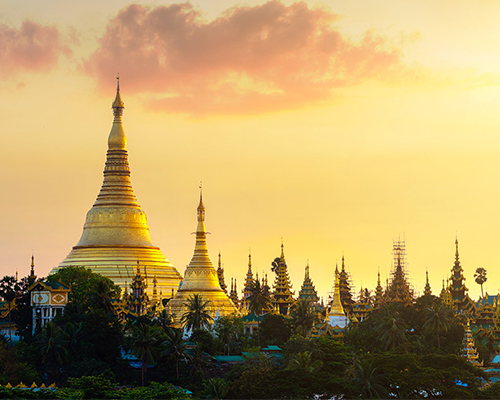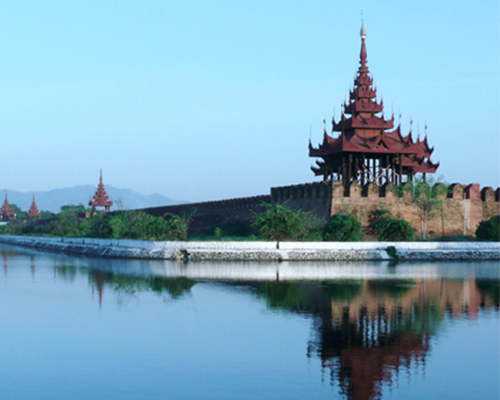Yangon and It's Environs
Yangon is the commercial capital of Myanmar and it is the main entrance to enter to Myanmar. We can reach by international flight via Bangkok, Singapore, China, India.
It is the main gateway to Myanmar. Evergreen and cool with lush tropical trees, shady parks and beautiful lakes, Yangon has earned the name of “The Garden City of the East”. Yangon was founded by King Alaungpaya on the site of a small settlement called Dagon when he conquered Lower Myanmar in 1755. The name Yangon means “End of Strife” which was anglicised as Rangon by the British. The present day Yangon covers 400 sq km and has a population of over 4 million.
Yangon is the most lovely city with over 6 million inhabitants, and surrounded by water on three sides. Formerly known as Rangoon, is a garden city of tropical lakes, with no skyscrapers, crowds or hectic pace of life. Many Colonial building and government, administrative buildings, which were built between the mid -19th century and the outbreak of World War II in 1940, are visible in this city.
Sightseeing Places in Yangon
World Famous the Great Shwedagon Pagoda
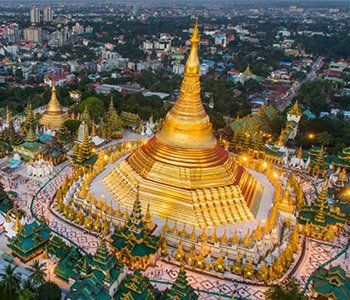 The main attraction of sightseeing in Yangon is world famous Shwedagon Pagoda, circling with many satellite Pagodas and ancient Pandals. Today the Pagoda itself is 326ft high, studded with 8688 solid Gold plates and each plate is of 1sq ft wide. Thousands of diamonds and precious colorful jewels are decorated on top of the Bud. The magnificent Shwedagon Pagoda towers the city, golden mystery and the most important pagoda in Myanmar. The pagoda dates back about 2, 500 years and was built to house eight scared hairs of Buddha.
The main attraction of sightseeing in Yangon is world famous Shwedagon Pagoda, circling with many satellite Pagodas and ancient Pandals. Today the Pagoda itself is 326ft high, studded with 8688 solid Gold plates and each plate is of 1sq ft wide. Thousands of diamonds and precious colorful jewels are decorated on top of the Bud. The magnificent Shwedagon Pagoda towers the city, golden mystery and the most important pagoda in Myanmar. The pagoda dates back about 2, 500 years and was built to house eight scared hairs of Buddha.
It is said to be believed that the Pagoda is built about 2500 years ago. But the recorded historical facts is written on a big broken stone slabs which was dug out from the ground at 12ft near the Pagoda by professor of Pali Language DrForhenmer in 1880 AD. On the slab is dated back to 1485 AD and is written by the Mon king Dhamazedi in two languages, Myanmar and Mon.
Whoever visited to this famous Pagoda has never been forgotten forever. Many small traditional shops with various kinds of crafts and arts works can be seen along the stairway up to the solemn shrine.
Whoever stroll around the Golden shrine on the platform, feels the sacred Peaceful atmosphere of quietness, is so wonderful that will never be forgotten to all the visitors.
Once the British Governor of Burma wrote in his book, Its’ beauty and serenity delights the eye. May I hope that its peaceful atmosphere is maintained to the fullness of time. The memory of this day will be forever in my mind. This is my last message to Burma.
Hubert Elvin Rance. (Governor of Burma)
Sule Pagoda
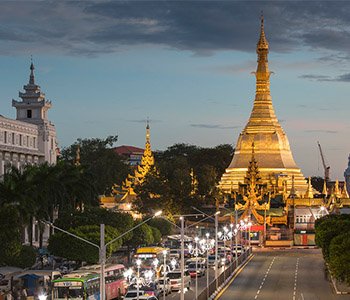 Situated in the heart of downtown, Yangon and it had said to be built over two thousand years ago. This Pagoda is also enshrined with Buddha’s hair relic.
Situated in the heart of downtown, Yangon and it had said to be built over two thousand years ago. This Pagoda is also enshrined with Buddha’s hair relic.
Kaba Aye Pagoda and MahapasanaGuha Cave
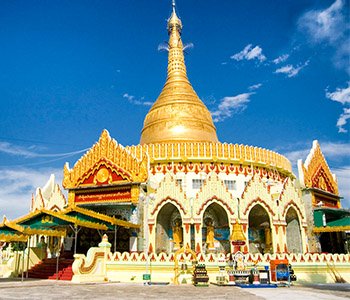 The world sixth synod of Buddhism was held in this cave building in 1954 on the Kaba Aye compound and the Pagoda was built to commemorate the sixth synod. This Pagoda was also enshrined with relics of Buddha and his disciples.
The world sixth synod of Buddhism was held in this cave building in 1954 on the Kaba Aye compound and the Pagoda was built to commemorate the sixth synod. This Pagoda was also enshrined with relics of Buddha and his disciples.
Botataung Pagoda
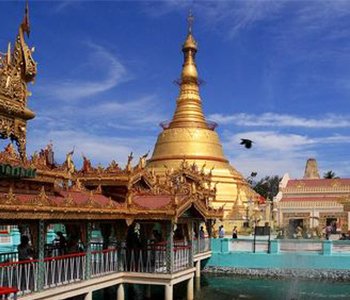
The Botataung Pagoda, this ancient monument situated nearby Yangon River, it’s just located on the bank of river and rising 40 meter. One thousand army leaders, who guarded the Buddha’s hair relics brought by the King Okkalapa about two thousand years ago, are earned the name of BotataungPagoda.The Pagoda was also enshrined with Buddha’s hair relic.
Other places of interest are, Bogyoke Aung San market, ChaukHtatKyi reclining Buddha Image, KyaukTawGyi white marble Image is the only largest image in Myanmar. National museum, Gem museum, China Town, Hlawga Wildlife Park, HtaukkyantAllied war cemetery and etc.
Kalaywa Monastery - Naga Hlainggu Hillock
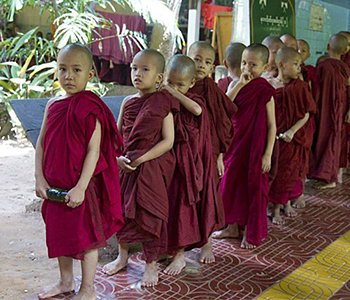
On this Naga Hlainggu Hillock are ancient pagodas and stupas and Buddha statues which were contemporaneous with Bagan Period. During 1938-39 miraculous sacred rays were seen radiating about the Hillock. Thus excavations were made here abouts and many ancient votive tablets with Buddha images in relief were found. So these religious objects were re-enshrined inside a new pagoda named Aung Chantha Pagoda which was constructed under the management of the Most Venerable Aboh Kalaywa Sayadaw.
So ancient Pagodas and stupas are found to have originated in these grounds which are still graced with Naga Hlainggu Aung Chantha Pagoda plus 28 ancient Buddha Statues.
This holy learning centre covers 17.016 acres of land on the second highest hillock in Yangon. Any visitor on arrival here is delighted with the green and verdant trees and plants growing all over the area. Instructor or student bhikkhus, samaneras, and nuns altogether numbering more than one thousand are conducting purit of Buddhist Scriptures as well as modern academic studies with happiness.
Desirous that worthy bhikkhus, samaneras, and nuns shall obtain fitting lodging while they pursue secular and religious studies here, this learning centre is being run under the management of Joint Secretary of the State Samgha Maha Nayaka Committe and Ovadacariya of the International Theravada Buddhist Missionary University, Vice Chairman of Administrative Body (Central) of the State Pariyatti Sasana Universities and presiding Monk of Naga Hlainggu Kalaywa Tawya Scriptural Learning Centre BHADDANTA JAGARABHIVAMSA (Aggamahapandita; Dvipitakadhara, Dvipitakakovida) so that the following five essential requirements could be fulfilled, viz.
Sightseeing nearby Yangon
Visit to Syrium (Thanlyin)
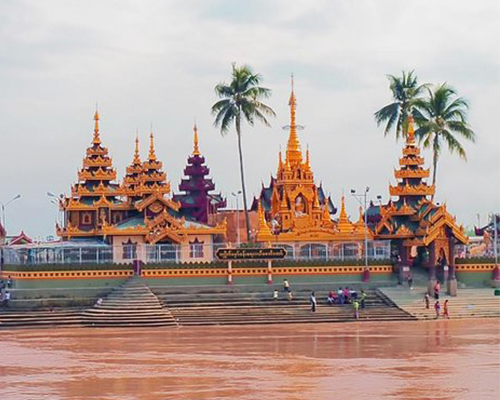
Buddhism was introduced about 2500 years ago and it was here that there are many Buddhist religious Shrines and Pagodas are spreading in Syrium. Christainity made its’ first inroads into Myanmar. Many merchants and adventurers start venturing into Syrium about 200 years ago.
In 10th century many traders from the sea attracted Syrium. Sailing ships from Malacca and Sumatra and as far as from Macca (middle east) came to trade from the west, Portuguese set up the base in Syrium. In 1581 Phillip Debrito settled long with Catholic mission on Syrium Port city. Debrito is notoriously known as Pirate for his tyranny. He played of Kingdoms against one another. He sided with Pegu Kings and recognized him as the master of lower province. The first Catholic mission, led by Father Bonabite came to Syrium in 1721. Built a large brick church in 1750. This large Church still exist in Syrium as old brick building.
Bago
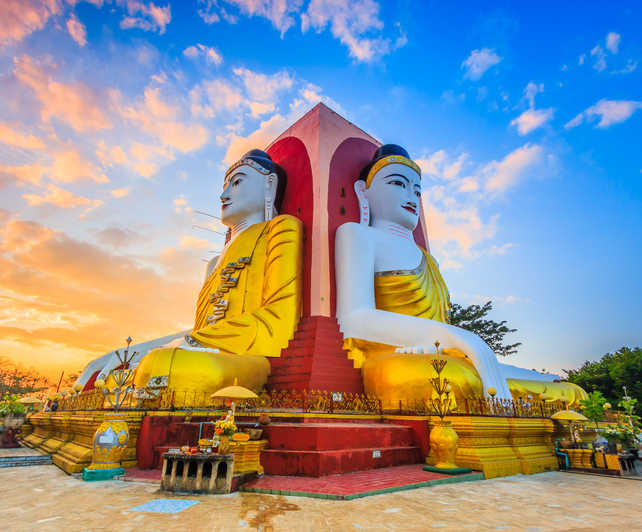
The Ancient City, once ruled by Mon Kings, is known as the OkthaPeguDynestyBago. The city was frequently mentioned by earlier Europeans visitors as an important seaport. Bago kingdom was under the rule of Baganempire during the reign of Bagan Kings, started from King Anawrahta in 1057 to King Narathihapati in 1287 AD. Than became the Capital city of Mon. Many of the Pagodas and Monuments had built during the rules of Kings in Bago. Today there are many famous Pagodas in Bago such as Shwe Maw Daw Pagoda about 2000 years ago is 373ft high, ShweThaHlyaung reclining Buddha Image from 994 AD is 180ft long, Kyaikpun ( Four Sitting Image ) without shelter is from 1476 AD and KalyaniSima ( Ordination Hall with 10 large stone scriptures ) are from1476 AD. The City is 40 miles from Yangon.
Tuntay
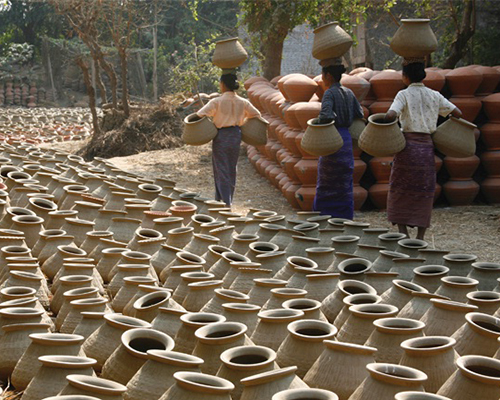
24 km from Yangon on the Tuntay canal. A craft drive across the Yangon River and one-hour car drive can reach Tuntay. Pottery is a major cottage industry. Shwesandaw Pagoda, Oh-Bo Pottery sheds, Baung Daw Gyoke Pagoda, Snake Temple, Kandaw Mingalar Lake and weavers are among the interesting sites.
Pyay
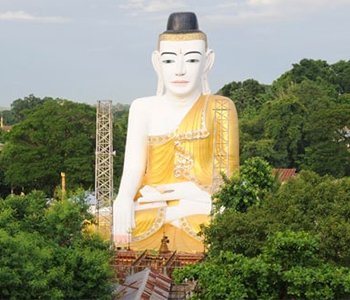
Pyay is located bout 285km north of Yangon. Situated on the east of Ayeyarwaddy riverbank. There are many Inns and Hotels, with modern facilities for visitors, in Pyay. Pyay is famous for its Archaeological site of the ancient city Srikhistra there are Many ancient Pagodas in the city of Pyay, Shwesandaw Pagodas and sitting huge sitting Buddha Statue are famous in Pyay.
Shwetaung
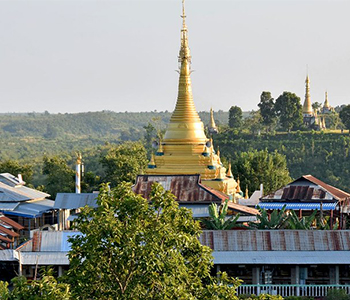
This small town about 14 km south of Pyay via the road to Yangon, contains two famous pagodas. The more well known is Shwemyettman Pagoda, “Pagoda of Golden Spectacles” and the second is Shwenattaung Pagoda, “Pagoda of Golden Spirit Mountain.” As a stupa site, Shwenattaung dates back to Thayekhittaya era.
AkaukTaung

(Old custom gate for boats in the river) is about 40 miles from Pyay on the Ayarwaddy river bank, where there are many huge carvings of Buddha images on wall of the rocks near the bank of Ayarwaddyriver, which can easily observe from the river by boat. At the end of the Second Anglo-Burmese war, Myanmar and British toll-posts were situated on Akauk Taung, a toll-hill in Myanmar language side by side. All boatmen had to pay tax to both posts. All sailing boats anchored close by the hill and waited till occasionally a week-long whirlpool ceased. The sailors prayed to God by carving Buddha images on the steep cliffside during that period. The mountain was named for the crafty toll-takers from the mid 19th Century.
Akauk Taung Mountain still stands on the bank of the Ayeyarwaddy River to the north of Pyay in Bago Region. It takes 15 minutes by boat sailing along the Ayeyarwaddy river to reach the Akauk Taung. Tourist can take remarkable photographs only from the boat which is in the middle of Ayeyarwaddy river.
Kyaikhtiyo (Golden Rock)

Kyaikhtiyo pagoda is located in the small town called Kyaikhto, in the Mon State. This destination is 160km away from Yangon. The pagoda is 1100km above sea-level. It is a 11 kilometer uphill climb for the hikers from Kinpun base camp. There is also a steep winding road for 4-wheel drive cars from the base to the nearest point of the pagodas. The pagoda is also known as “the golden rock”. The meaning of KyaikHtiYo : According to Mon tradition, the name is a corruption of Kyaiki-thi-yo being derived as follows. In Mon language the word “Kyaik” means ” pagoda” and ” yo” ” to carry on the hermits head”, in Pali the word” ithi” means a hermit and therefore the name means ” the pagoda carried on the hermit’s head.
It is said that the boulder has been over 2500 years. The tradition is that after the hermit had obtained the hair from the Buddha, he was carrying it on his head inside his hair knot till he found a boulder which resembled his head, and so he built the pagoda on its enshrining the relic, substituting the boulder for his over head.
On the extreme verge of this sloping rock table, and actually over hanging it by nearly half, is perched this wonderful boulder (now completely gilded with gold), thirty feet high and surrounded by the pagoda. By gently rocking the boulder a thread can be passed underneath; seemingly appears as if the additional weight of a few pounds, or a strong wind, would send it sliding down from the place it has occupied for unknown centuries watching over three thousand feet into the sloping valley beneath and we know what freakish law keeps it in its position. Anyway pious Buddhists attribute it to the power of the relic enshrined in the pagoda.
This relic is a hair of Gotama Buddha given to a hermit residing on the mountain by the Buddha himself as he was returning from the second heaven of the Nats whither he had gone to preach the law to his mother.
Structure
The pagoda, about 18 feet high, and 50 feet in girth. is situated on the hill of the same name on the ridge between Sittaung and Thanlwin. It is built on a huge, almost egg- shaped, rounded granitoid boulder perched on the very summit of a projecting and shelving tabular rock, which in itself is separated several feet from the mountain by a rent or chasm, now spanned by a small foot bridge of iron and on the further side drops perpendicularly into a valley blow.
One of the wonder of the world ,Kyaikhtiyo Pagoda ( Golden Rock ) , known as the Golden Rock (built in 574 B.C ). It lies 229 km far from Yangon and built on a huge boulder which stands on the extreme edge of the cliff, 3625 ft( 1095.45 m ) above sea level. Some marvelous facts about the Golden rock are as follows: • Volume of the Rock : 244.58 M3 • Density of the Rock : 2.5 Ton/M3 • Weight of the Rock : 611.5 Tons • Height of the Rock : 8.15 m (26ft , 9 in) • Kind of the Rock : Granite • Contact area : 0.714 sq-m ( 7.69 sq-ft ) • Volume of the Stupa : 9.26 M3 • Density of the Stupa: 2.1 Ton/M3 • Weight of the Stupa: 19.45 Tons • Height of the Stupa : 33ft , 2 in
Kyaikhtiyo Pagoda Festival
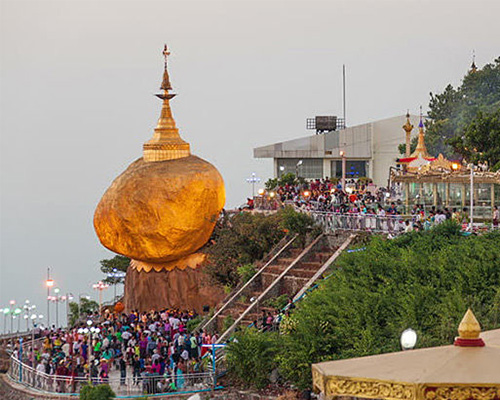
It is of considerable celebrity and attracts crowds of worshippers annually beginning from October to March which is the seasonal pilgrimage period for worshippers Especially on the full moon day of Tabaung, the platform of the pagoda is lighted with ninety thousand candles offered to the Buddha and thousands of worshippers gather around the pagoda offering fruits, foods incense to the Buddha. Sometimes reflected rays of color from the Buddha’s image were said to have been observed by the worshipers.
There are only two hotels on the top of mountain (Kyaikhto Hotel & Mountain Top)…although the location is quite good and view is nice, facility is not comparable as city area hotel. Another some hotels are also available in Kyaikhto city (base camp).

